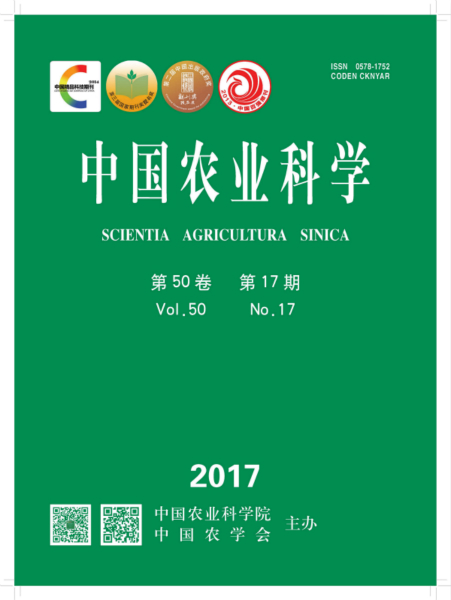-
Comprehensive Evaluation and Indicators of the Drought Resistance of Different Genotypes of Fagopyrum tataricum at Seedling Stage
- LU ZhiJuan, ZHANG YongQing, ZHANG Chu, LIU LiQin, YANG ChunTing
-
Scientia Agricultura Sinica. 2017, 50(17):
3311-3322.
doi:10.3864/j.issn.0578-1752.2017.17.006
-
 Abstract
(
484 )
Abstract
(
484 )
 PDF (489KB)
(
716
)
PDF (489KB)
(
716
)
 Save
Save
-
References |
Related Articles |
Metrics
【Objective】Fagopyrum tataricum not only has rich nutritional and medicinal values, but also has great physiological characteristics such as relatively high tolerance and strong adaptation ability to cold and barren conditions. There is a significant difference in resistance to drought stress among different genotypes of F. tararicum. Study of drought resistance characteristics of F. tataricum, screening of the materials of high tolerance genotypes and identification of indicators of drought resistance, and building a mathematic model for appraising the drought resistance not only can provide a foundation for evaluating the drought resistance and selection of genotypes, but also can provide a theoretical basis for germplasm breeding in cold areas of Loess Plateau. 【Method】Multiple indices of seedlings, including agronomic traits and physiological characteristics, were measured in the normal supply and drought stress with nine F. tataricum genotypes. Subordination function method, principal component analysis and clustering analysis were used to synthetically evaluate the drought resistance of different F. tataricum genotypes. Moreover, stepwise regression analysis was used to establish the optimal regression equation that could forecast and identify the drought resistance ability of F. tataricum. 【Result】Drought stress has an obvious effect on the indexes of F. tataricum at seedling stage. Results of difference of testing indices showed that the overground index, root dry weight, root activity, root morphology index, soluble protein contents, relative water content, chlorophyll content and leaf fluorescence parameters under drought stress were obviously decreased compared with the control group. Compared with the control group, drought stress not only resulted in the decreases of aboveground and root characteristics, root activity, soluble protein contents, leaf relative water and chlorophyll content, Fm and Fv/Fm, but also resulted in the increase of the activities of superoxide dismutase (SOD) and peroxidase (POD), the contents of malonaldehyde (MDA) and soluble sugar, and leaf Fo. Besides, the root-shoot ratio of drought tolerance genotypes showed a rising trend, while the intermediate and drought-intolerant genotypes showed a declining trend. The principal component analysis turned 21 single indices into three independent comprehensive indices (accumulative contribution of 87.30%). The principal component 1 mainly reflected the information of biomass, root morphology, and leaf fluorescence parameters etc. The principal component 2 mainly reflected the information of root activity, root enzyme activity and osmotic adjustment substances etc. While the principal component 3 mainly reflected the information of aboveground morphology, partial leaf and root physiological characteristics. Nine F. tataricum genotypes were divided into three categories by clustering analysis: drought-tolerant type, middle type, and drought-intolerant type. In order to predict the drought resistance of each genotype and build a mathematical evaluation model, D values and drought tolerance index of various indexes were taken as the dependent variable and independent variable, respectively, for the stepwise regression analysis. By establishing an optimal regression equation, eight influential indices for drought resistance, including plant height, stem diameter, root-shoot ratio, root activity, main root length, MDA content, Fo, and leaf relative water content, were selected. The predictive values of drought tolerance of nine F. tataricum had a significantly correlation with D values (R2=0.988**), which showed a certain accuracy and efficiency to forecast the F. tataricum drought-resistance by using this equation. And the identification work could become easier when measuring these indexes selectively. 【Conclusion】Drought stress has significant influence on each index during seeding stage of F. tataricum. According to the cluster trend diagram, the tested categories can be divided into three types: drought tolerance type (including Diqing kuqiao, Xinong 9909, Qitai farmers), intermediate type (including Guangku 1, Qianku 6 and Yunqiao 1), and non drought-intolerance type (including Duoyuan kuqiao, Heifeng 1 and Xiqiao 1). The study selected the nine indexes including plant height, stem diameter, root-shoot ratio, root activity, main root length, MDA content, Fo, and leaf relative water content, which could rapidly identify the drought resistance of F. tataricum, and the predictive values of drought tolerance is significantly correlated with D values (R2=0.988**).









